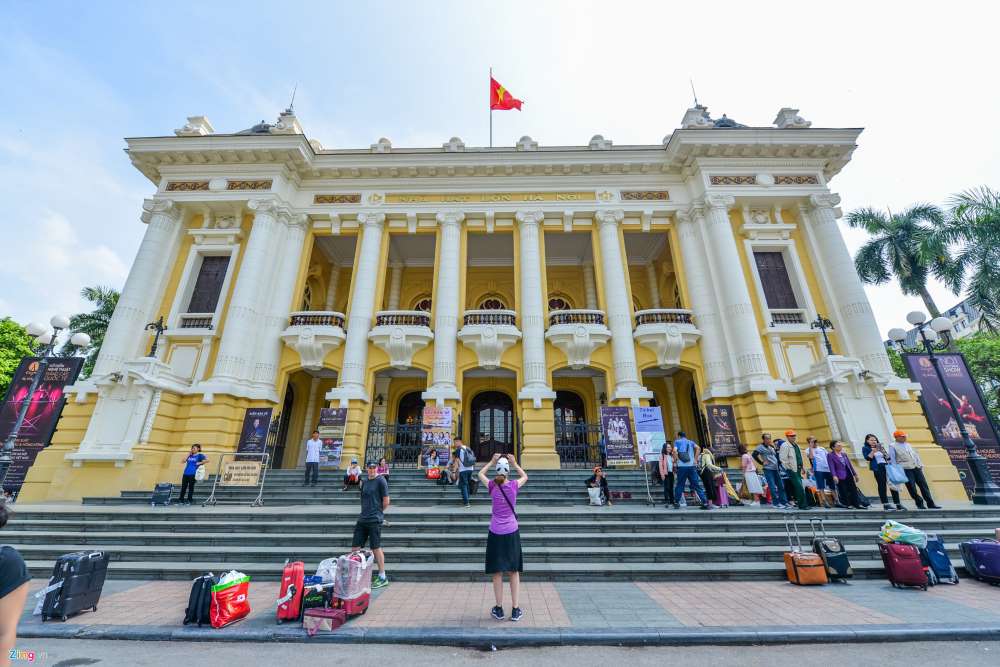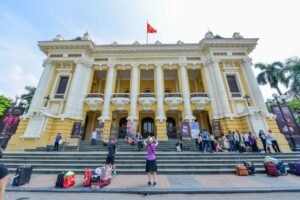Hanoi Opera House is a theater in Hanoi, Vietnam; is located on the Square of August Revolution, at the junction of Trang Tien Street, Phan Chu Trinh, and Ly Thai To-Le Thanh Tong near Hoan Kiem Lake and Vietnam History Museum.
This is one of the cultural centers of Hanoi’s capital; a place where cultural activities, performing arts, music, concerts, and exchanges take place regularly.
Hanoi Opera House is a unique architectural work with outstanding historical, cultural, architectural, and artistic values.

History of Hanoi Opera House
Since arriving in Hanoi in 1883, the French government in Vietnam has intended to build a cultural-artistic center to serve their needs of enjoying art.
Hanoi Opera House started construction in 1901 and was completed after 10 years. The masterpiece of art was designed by two architects Broyer and Harley, later with the collaboration of architect François Lagisquet, based on the model of the Opéra Garnier theater in Paris.

Therefore, the Hanoi Opera House is imbued with classical European architecture, perfect to every detail, providing the most luxurious and academic art space in Indochina.
As soon as the Opera House was completed, the French organized art performances of musicals, pantomimes, symphony concerts, and ballet… with the aim of enjoying as well as bringing French culture into Vietnam.
After 1945, the Hanoi Opera House became the meeting place of the Government, the National Assembly, military parades, and many Vietnamese theater troupes were able to rent the theater to perform.
Along with the formation of the city’s urban class and new intellectuals, the Hanoi Opera House became an exciting place for the artistic activities of Vietnamese artists at that time.
After the French withdrew from Hanoi, the Vietnamese Government continued to preserve and develop the Opera House according to its original function.
Towards the end of the 20th century, after more than 80 years of existence, the Hanoi Opera House fell into serious disrepair, so the Vietnamese Government decided to restore the work.
The project started in 1995 and was completed in 1997, under the supervision of French-Vietnamese architect Ho Thieu Tri. This is also the first and only restoration of the Theater until now.
Today, the Hanoi Opera House is one of the largest theaters in Vietnam, with many academic art shows, and is also a tourist attraction when coming to Hanoi.
The architecture of the Hanoi Opera House
Right from the outside of the theater, we can feel the “breath” of Europe with delicate lines and classical carvings.
The Opera House is divided into 3 main areas: the main hall, the audience room, and the mirror room.

The main hall
Entering the main hall, visitors cannot help but feel overwhelmed by the splendid splendor here. The whole room is paved with white stone imported from Italy; covered with red carpet in the middle aisle; creating a noble and noble feeling like the British royal palace.

An audience room
Next is the audience room where the current performing arts activities are taking place. With 598 seats reasonably distributed for 3 floors, creating the most comfortable viewing space.
Finally, the mirror room, where important ceremonies are held or welcoming high-ranking characters …

The mirror room
In addition, inside the Hanoi Opera House, there are also some other auxiliary works; such as an administration room, 18 dressing rooms, 2 vocal training rooms, a library, and a meeting room.
When you come to the theater, visitors can buy some small souvenirs at the galleries and sell souvenirs.
Where is Hanoi Opera House
The Opera House is located at 01 Trang Tien Street, Hoan Kiem District, Hanoi. In front of the theater is August Revolution Square. To the right is the Hilton Opera Hotel. Around the theater, there are other works such as History Museum, Government guesthouse…
The location of the theater is ideal, and convenient for visitors to visit. After arriving at the theater you can easily visit nearby places.
How to get to Hanoi Opera House
Hanoi Opera House is located right in the city center, so you can move here by bus, car, motorbike, or taxi.
If you take a bus, there are some of the following bus routes that have routes that pass Hanoi Opera House: 02, 35A, 43, 49, 55A, and 86CT.
If you go by car or motorbike, then follow the route: Le Thai To go towards Hang Trong – Hang Khay – Trang Tien through the roundabout of August Revolution Square to reach the Hanoi Opera House.

Double-decker sightseeing bus in Hanoi
Alternatively, you can also try taking a double-decker Hanoi City Tour bus departing from Dong Kinh Nghia Thuc Square to August Revolution Square.
Hanoi Opera House Tours & Tickets
Recently, the Hanoi Opera House officially announced opening its doors to visitors with a fee of 400,000 VND / person.
In addition, you can buy tickets at the theater for the price of 300,000 – 1,000,000 VND / person and take advantage of a visit to some beautiful architectural works here.
After enjoying the beauty of European architecture in the heart of Asia of the Hanoi Opera House, you can also walk around the surrounding areas to relax and enjoy the taste of Hanoi.
Opening hours for visitors
The Hanoi Opera House will be open to the public on Monday and Friday every week and can add other sessions depending on the month. The tour lasts for 1 hour and 30 minutes from 10:30 to 12:00.
The tour will begin with an understanding of the architecture and history of the theater’s construction. The main hall, the T-staircase, the auditorium, and the mirror room, … will all appear before your eyes.
Besides, visitors also have the opportunity to try on VIP seats, and learn about ancient documents, pictures, and hand-painted designs of the theater, …
The second part of the tour is to enjoy unique art performances in the field of ethnic musical instruments, drama, and puppetry, …
August Revolution Square
The squares in Hanoi were formed in the late 19th century and early 20th century. Which, the most prominent is Hanoi Opera House Square, associated with the adjacent Opera House.
After 1994, this square was also known as August Revolution Square, or August 19 Square to mark the historical event that happened here in 1945.

Photo: baotintuc.vn
Around the square, there are famous architectural works such as the Hanoi Opera House, Vietnam History Museum, and Hilton Hanoi Opera Hotel.
In the evening, when the Hanoi Opera House is lit with shimmering lights, the Square area becomes more and more beautiful, becoming a place of familiar community cultural activities of the people of the capital.


